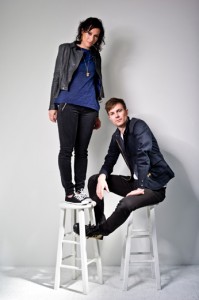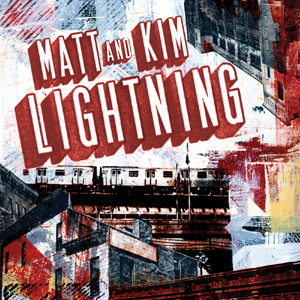Matt & Kim: Underwear Recording, and other Home Studio Scandals
WILLIAMSBURG, BROOKLYN: Imagine becoming Matt & Kim on a whim.
Well, that’s what happened to…Matt & Kim. The magic musical pair had a fateful meeting as Pratt art students in 2004, and have managed to always seem smashingly (s)punky – live, in the studio, and in their vivacious videos – ever since.
Now the welcome trend continues with this week’s release of the Brooklyn group’s 4th studio album, Lightning. Hotly anticipated by an always-expanding fan base, Lightning sees the energetic pop punk couple – aka singer/keyboardist Matt Johnson and drummer Kim Schifino – stripping layers off of their brash sound.
As a result, fans can now expect to get even closer to Matt & Kim’s high-energy core, like on the lead single “Let’s Go”, where jump-rope rhythms underpin soaring OOOOOO’s, Johnson’s trademark in-your-face verses, and what may be the world’s catchiest chorus.
The band has attempted multiple recording scenarios to make their records – from L.A. studios to childhood homes – but Lightning saw the DIY band working within a whole new permutation. Johnson, who took the lead on recording and engineering Lightning, told SonicScoop about the pleasures of underwear audio and much more, speaking a mile a minute from Matt & Kim’s new digs in Bedford Stuyvesant.
Where in Brooklyn did Lightning get recorded?
We had moved out of our apartment, and were just using it as a studio, because we bought a house here in Bed Stuy. This was our last hurrah! We had lived in Williamsburg for eight years, and just moved out.
We had neighbors right up against the walls there. But they were loud, we’re loud, and we had an unsaid thing where no one complained, which was kind of miraculous.
Did you record Sidewalks (2010), Grand, (2009), and Matt and Kim (2006) in traditional recording studios? What were those experiences like for the band?
When we did our first album (Matt and Kim), we had to do that in nine days due to budgetary constraints, at Infrasonic Studios in L.A.
Then for Grand, we didn’t have much money to make that one, and we just wanted enough time to try what ever stupid shit we wanted to try, so we did that in the Jacksonville, Vermont home where I grew up. If we wanted to be able to try a harmonica kazoo thing, we wanted enough time — that’s why we did Grand that way.
For Sidewalks, we liked [Producer] Ben Allen, and we knew we wanted to work with him from his work with Gnarls Barkley, so we recorded that in his Atlanta studio.
What made you want to switch to a home-based setup for Lightning?
Me and Kim realized: We do everything together. We live together, we’re together as a couple, we’re business partners. We’re just in synch.
We feel like we know exactly what we want, and want to learn from each other. I had done a song collaboration with Andrew W.K., and realized over the course of the years since we had done Grand, that we could do the production right and do it ourselves. We had some engineering help, but I had learned more for this album.
We work in Logic, and do a lot of writing in Logic, with all the synths in there and a (MIDI) keyboard. Other than those drums, there’s a lot of it in the box, which we just kind of reamp.
I like a lot of personality — I don’t like it to sound perfect. The one thing that I think is impossible (to do in an apartment) is drums. For drums you need space. If you have a bad-sounding room, you’ll have bad drums. Converse has the studio Rubber Tracks, so we went and recorded drums over there, with Aaron Bastinelli engineering. Plus, Lars Stalfors mixed the song “Tonight.”
In the end, I feel like I made 75% of this album in my underwear — because when you don’t’ leave your home, you don’t need any clothes. There was a lot of underwear recording going on, for both me and Kim.
How did you actually adapt the apartment to recording?
Well, initially we thought we were going to try to hush the sound a bit, and try to make it so that our neighbors wouldn’t get pissed. These are Brooklyn, paper-thin walls, so we hung thick carpeting across the length of the apartment. It deadened the space, but I don’t think it really helped (laughs)!
I still can’t believe I’d be doing vocals at 2 AM screaming. I feel like now that this album is done, I need to just leave a copy leaning against our neighbors’ door with a big “Thank you” note that says, “This is what we’ve been doing the last six months making all that noise across the hall. Enjoy!”
What else kept this Brooklyn apartment recording project interesting?
The other challenge was being next to the highway, the BQE. I’m sure if you listen closely, you’ll hear some BQE in the background of the vocals.
I really like to heavily compress my vocals, like three or four times over. Especially when those quiet noises started to come up, we we’re like, “Oh man, the highway is coming out.”
So we used amateur techniques with blankets, and using the sE Reflexion filter for doing the “doo-doos” by myself. I got one decent Brent Averill 1073 mic pre clone and JDK R24 for tracking vocals, and my go-to Shure SM7, and it ended up being happy.
What else was in your recording setup for Lightning?
I used a Mac Pro that I bought in 2008 to mix Grand, when my 2004 Power Book was croaking trying to finish it. It’s 8-core 2.8 ghz. I did put in a solid state drive before this album, and it was like using a brand new computer.
I used a 003 for A/D D/A which wasn’t perfect with Logic but did OK. I summed using a Dangerous D-Box. On some songs I could really tell the benefits of outboard summing, on others I really didn’t seem to notice much of a difference.
Tell us more about how you apply all that compression to the vocals.
I self-proclaim that I have very little idea of what I’m doing. I go by what sounds and feels right.
I have a tough time committing to tape. I’m an adjustment-crazed person, and I have a tough time mixing with other people. Because I’m the one who will drive you insane — making changes a million times.
— David Weiss
Please note: When you buy products through links on this page, we may earn an affiliate commission.









